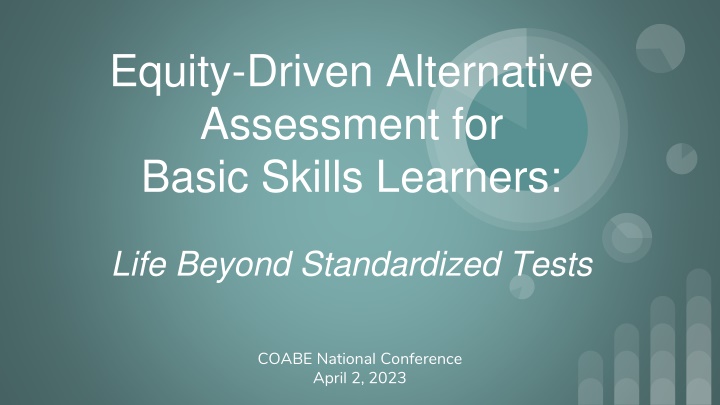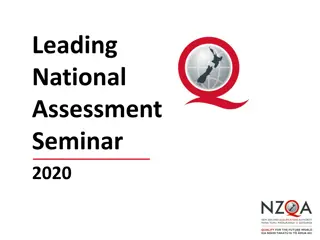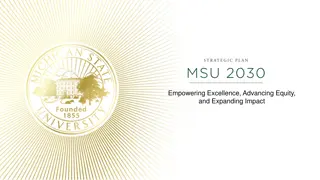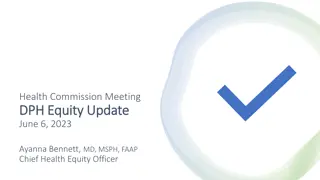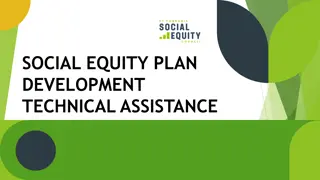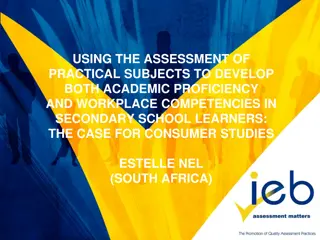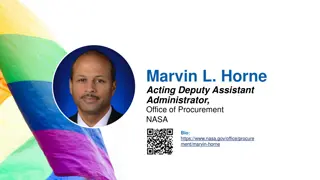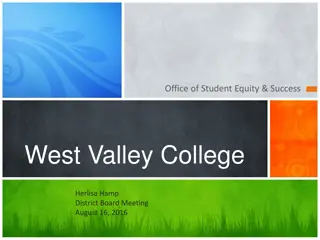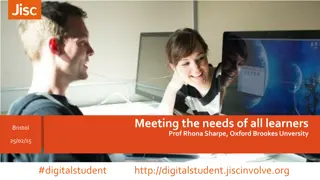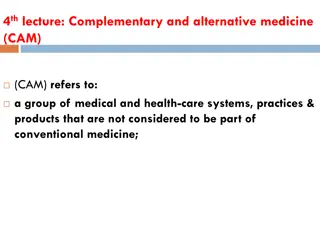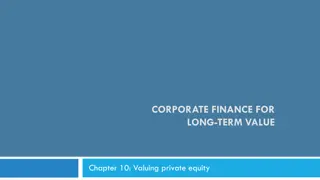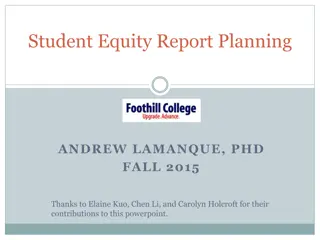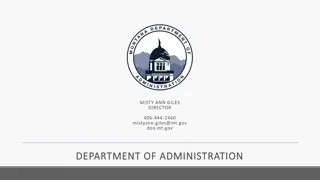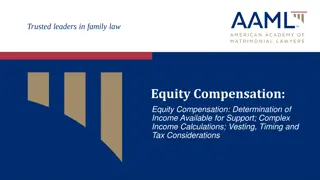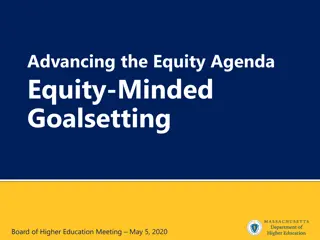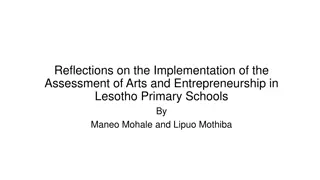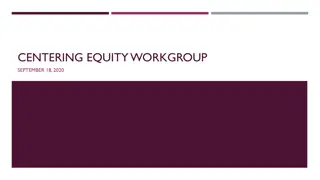Equity-Driven Alternative Assessment for Basic Skills Learners
Innovative approaches to assessment beyond standardized tests for basic skills learners. Join the team from Washington State as they discuss alternative assessment models at COABE National Conference.
Download Presentation

Please find below an Image/Link to download the presentation.
The content on the website is provided AS IS for your information and personal use only. It may not be sold, licensed, or shared on other websites without obtaining consent from the author.If you encounter any issues during the download, it is possible that the publisher has removed the file from their server.
You are allowed to download the files provided on this website for personal or commercial use, subject to the condition that they are used lawfully. All files are the property of their respective owners.
The content on the website is provided AS IS for your information and personal use only. It may not be sold, licensed, or shared on other websites without obtaining consent from the author.
E N D
Presentation Transcript
Equity-Driven Alternative Assessment for Basic Skills Learners: Life Beyond Standardized Tests COABE National Conference April 2, 2023
The Team from Washington State Jennifer Barber - South Puget Sound Community College Curtis Bonney - North Seattle College Will Durden - State Board for Community and Technical Colleges Kim Flack - Tacoma Community College Sherri Fujita - Spokane Community College Cat Howell - Literacy Source
Where Do You Work? Respond to our poll in the Whova app.
Turn & Talk Close your eyes and think back on your educational journey. 1. Are you someone who tests well? Do you have test anxiety? 2. Is there a standardized test in your history that had meaning or power? Reflect on that experience. What kind of reaction did you have? Talk to someone near you or share your reflection in the chat.
Agenda 11:45-1:00 Introductions and Goals for Presentation State Board for Community and Technical Colleges (SBCTC) Overview/WIOA Turn & Talk Alternative Self Placement Turn & Talk Data & Practices Rationale/Proposal Q&A
Goals for Today Review how standardized tests can work as a barrier Show how Washington state providers use multiple measures to accurately place and assess students Encourage a national move to alternative assessment models, funding, and systems
Word Cloud Think of a word that represents one of the challenges that standardized tests pose for practitioners and/or students. Add your word to the word cloud.
WA State Board (SBCTC) Vision Leading with racial equity, our colleges maximize student potential and transform lives within a culture of belonging that advances economic justice in service to our diverse communities racial, social, and BEdA Goal #1: Intentionally review, develop and implement culturally responsive policies and practices that promote racial and economic justice.
Overview of Washington State System Title II funds come to the community and technical college system (SBCTC), which funds all thirty-four colleges as well as five community-based organizations. We use CASAS exclusively. High School + does not require testing per OCTAE Program Memo 17-2. Our I-BEST programs rely on MSG 3 (postsecondary transcript) in lieu of post-testing.
State Perspective March 23, 2020 - State Lockdown Almost two years remote with limited exceptions- local variations in how long and to what extent. Providers embraced and experienced success with a variety of methods to place and assess students We advocate for research pilots to explore these and other methods to place and advance students in addition to the test and within the performance accountability system already established by the law.
Long Term Outcomes: Table 5 Summary Core Follow-up Outcome Achievement | All Periods of Participation 2018 2019 2020 2021 27% 29% 32% 37% 2nd Qtr Employment 28% 29% 34% 35% 4th Qtr Employment $5,000 $5,400 $5,600 $6,000 2nd Qtr Median Earnings 12% 11% 12% 11% HS Credential & Transition 23% 24% 25% 22% HS Credential & Employment 63% 63% 83% 82% Postsecondary Credential 54% 53% 63% 59% Any Credential
Turn & Talk How did you place students and measure gains during the pandemic/shutdown? Did things change? How so? Did you continue with any of those changes?
Alternative Placements and Measurable Gains Perspectives: Literacy Source (CBO) Spokane Community College North Seattle College Tacoma Community College South Puget Sound Community College
Literacy Source NRS aligned level completions for productive skills: Students demonstrate competencies for level through final projects Ready to Work level final paragraph project: Project directions, scoring rubric English for Community Connections (ESOL 4-6) Final Podcast project NRS aligned writing test for placement and level completion demonstration Basic writing assessment, Essay writing assessment, writing rubric NRS aligned speaking test for placement and level completion demonstration Speaking assessment & rubric
Literacy Source Program Data during Pandemic alternative measures period from Literacy Source
Literacy Source Alternative goal attainments we track that are currently not counted - and should be! Citizenship attainment GED subtests, GED Ready tests Workforce skills certificates (e.g. child care license, food handler s permit) Digital skills goals completions (system lacks aligned rubrics)
Spokane Community College Urban and suburban college - 13,300 students Adult Education - 1,800 (ESL, HS+/GED, Pre-Apprenticeship, I-BEST, College Prep) Regional Accreditation: Northwest Commission on Colleges and Universities Guided Pathways Campus: No prerequisites for most professional and technical programs English: directed self-placement Math: multiple measures Adult Education on pathway maps Adult Education Division: Courses are approved by the campus Curriculum Committee. Outcomes are aligned with NRS levels and Appendix B descriptors Students are placed using writing samples, interviews, and directed self- placement Faculty grade courses according to course outcomes
North Seattle College Career and College Readiness Standards (CCRS)-aligned/NRS-aligned activities and assessments in ELA/ESL - using appendix B (NRS Level Descriptors for ABE/ESL). Focus on productive skills - writing, communications, and digital literacy Example ESL 3 Questionnaire for student self-placement in I-BEST programs instead of using CASAS to determine eligibility. Directed self-placement helps students to think about their academic backgrounds, their strengths and challenges, and their goals, as they begin an I-BEST career pathway.
Tacoma Community College - Participant Placement - Equity, Agency and Capacity Placement College-wide Directed Self Placement Reading/Writing - Intro ABE through ENGL& 101 BEdA specific Math Directed Self Placement ELA Directed Self Placement - guided conversation with intake staff
Tacoma Community College Measurable Gains ELA multiple measures - Guided self-progress conferences and checklist- empowers students, promotes agency Self-reflection paper - evidence-based process that requires critical analysis of progress - compared to outcomes and anchor examples - sample student reflection Portfolio Checklist- Collection of work demonstrating outcomes met Single Point Rubric - more intentional focus on feedback in each dimension, easier and more meaningful for students, especially English Language Learners ABE multiple measures - Standards-based final writing assessments and Rubrics IBEST / College and Career Pathway Academy Personal Statement - Standards-based Writing assignments and Rubrics HS+ - Competency-based English Credit Rubric Portfolio Panel - Student Presentation
Tacoma Community College NRS Federally Reportable Measurable Skill Gains (MSG) - 11-35% Federally reportable Students & challenges collecting data at intake - many students did not show in outcomes Challenges with post testing, especially for ELA during remote operations Alternative to MSG - Equitable and valid measures of student success Aligns with institution-wide measures - Tableau dashboards managed by Institutional Research Successful Course Completion - Grades 2018 to 2022 - Average 85% successful course completion Retention quarter to quarter 75 to 81% fall to spring 56 to 69%
South Puget Sound Student Success Rates Year Pass Rate Modality 2017-2019 82% in person 2019-2021 76% online
Rationale for Multiple Measures Equity Accessibility Contextualized/authentic to coursework Improve cooperation with workplace partners and training providers Facilitate large-scale fully remote learning
Options Moving Forward Short term ask: Ability to pilot multiple measures for placement and gains to demonstrate the efficacy of multiple measures. Could be authorized via Section 169 of WIOA or via a reauthorization of WIOA. Long term ask: Align course outcomes with CCRS and use classroom assessments to measure gains.
Next steps Connect with us if this resonates with you Join us for a follow up conversation April 17th at 1 PM PST Zoom link Connect with COABE
Presenter Contact Information Sherri Fujita sherri.fujita@scc.spokane.edu Cat Howell cath@literacysource.org Curtis Bonney Curtis.Bonney@seattlecolleges.edu Kim Flack kflack@tacomacc.edu Jennifer Barber jbarber2@spscc.edu Will Durden wdurden@sbctc.edu
Bibliography AAUP Ibram X. Kendi https://www.aaup.org/article/why-standardized-tests-have-standardized-postracial- ideology#.YTFT552pHD7 National Education Association: good historical overview, and there are sources listed at the bottom of the article we can use. A Civil Rights Challenge to Standardized Testing in College Admissions, Harvard Civil Rights Civil Liberties Law Review https://harvardcrcl.org/a-civil-rights-challenge-to-standardized-testing-in-college-admissions/ Ensuring All Students Have Access to Higher Education, The Role of Standardized Testing in the Time of Covid-19 and Beyond, Lumina Foundation https://www.luminafoundation.org/resource/ensuring-all-students-have-access-to-higher-education/ Association of American Colleges & Universities, The Proof Is in the Portfolio https://www.aacu.org/publications-research/periodicals/proof-portfolio Race gaps in SAT scores highlight inequality and hinder upward mobility, Brookings Institute https://www.brookings.edu/research/race-gaps-in-sat-scores-highlight-inequality-and-hinder-upward-mobility/
Standardized Tests & Racism Kendi, I. X. (2019). How to be an antiracist. New York: One World. The use of standardized tests to measure aptitude and intelligence is one of the most effective racist policies ever devised to degrade Black minds and legally exclude Black bodies. We degrade Black minds every time we speak of an academic-achievement gap based on these numbers. The acceptance of an academic-achievement gap is just the latest method of reinforcing the oldest racist idea: Black intellectual inferiority. (Chapter 8 discusses racism in standardization)
Rethinking Education Most colleges are now dominated by conservative ideologies, hooked on methods, slavishly wedded to instrumentalized accountability measures, and run by administrators who lack either a broader vision or critical understanding of education as a force for strengthening the imagination and expanding democratic public life. Teaching to the test and the corporatization of education become a way of taming students and invoking modes of corporate governance in which public school teachers become deskilled and an increasing number of higher education faculty are reduced to part-time positions, constituting the new subaltern class of academic labor. Giroux, H. A. (2010). Rethinking Education as the Practice of Freedom: Paulo Freire and the Promise of Critical Pedagogy. Policy Futures in Education, 8(6), 715 721. https://doi.org/10.2304/pfie.2010.8.6.715
